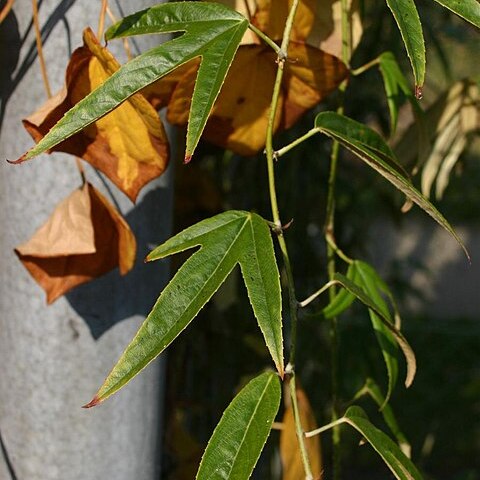Shrubs climbing, to 6 m tall, evergreen. Branchlets brown or reddish brown, densely tomentose at first, subglabrescent, with sparse, slightly curved small prickles. Leaves simple; petiole 3–6 cm, slender, tomentose; stipules oblong or oblong-lanceolate, free, 1–1.8 cm × 3–7 mm, membranous, villous, margin entire or apically with 2 or 3 teeth, apex acuminate; blade 8–15 × 7–14 cm, leathery, abaxially densely gray or yellowish gray tomentose, sometimes with sparse, minute prickles on raised veins, adaxially lucid-green, glabrous, base broadly cuneate to subrounded or cordate, palmately 3–5-lobed; lobes lanceolate or narrowly oblong to ovate-lanceolate, 7–11 × 1.5–2.5 cm, margin with sparse, coarse or thin sharp serrations, apex acuminate. Inflorescences terminal or axillary, racemes, 7–12 cm, 9–20-flowered; rachis and pedicels densely gray or yellowish white tomentose and villous, with few minute needle-like prickles; bracts oblong or oblong-lanceolate, 1–1.5 cm × 4–7 mm, membranous, villous, margin entire or apically with few teeth, apex acuminate. Pedicel 5–10 mm. Calyx ca. 1.5 cm, gray or yellowish white tomentose and villous, sometimes with intermixed glandular hairs; sepals reflexed after anthesis, narrowly triangular, 6–10 × 3–5 mm, margin entire, apex acuminate to caudate. Petals reddish, narrowly ovate, 7–9 × 3–6 mm, both surfaces pilose, base shortly clawed, margin erose or minutely crenate, apex obtuse. Stamens many, nearly as long as petals, villous. Pistils slightly longer than stamens, villous. Aggregate fruit black, subglobose, 1.3–1.5 cm in diam.; persistent styles reddish, villous; pyrenes somewhat reticulate. Fl. May–Jun, fr. Jul–Aug.
More
A climbing shrub. It keeps its leaves throughout the year. It grows 6 m long. The young branches are brown with a coating at first. There are a few small curved prickles. The leaves are 8-15 cm long by 7-14 cm wide. They have 3-5 lobes. There are 9-20 flowers in a group near the end of the branches. The petals are red. The fruit are aggregate and black. They are 1.3-1.5 cm across.
Can be grown by cuttings or seedlings. Seeds needs stratification.

